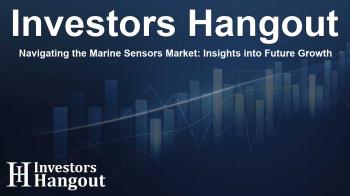Navigating the Marine Sensors Market: Insights into Future Growth

Marine Sensors Market Overview
The Marine Sensors Market is on a growth trajectory, projected to expand from an estimated size of USD 1.4 billion in 2023 to roughly USD 1.9 billion by 2028. This growth reflects a compound annual growth rate (CAGR) of 6.5%, indicating a strong upward trend in this vital sector.
Driving Forces Behind Market Growth
Several factors are propelling the demand for marine sensors. A notable influence is the increasing utilization of unmanned underwater vehicles (UUVs) and autonomous underwater vehicles (AUVs). As maritime transportation evolves, navies and commercial sectors prioritize advanced and technologically sophisticated marine vessels, hence stoking demand for innovative marine sensors.
Technological Advancements in Marine Sensors
Technological innovations have significantly transformed the marine sensors industry. Current advancements encompass high-resolution sonar systems, improved telemetry modules, and advanced imaging sensors, which enhance underwater observations and operations. The rising adoption of such technologies significantly influences market dynamics.
Key Players Shaping the Marine Sensors Landscape
Leading companies in the Marine Sensors Industry include Honeywell International Inc., Eaton Corporation, TE Connectivity, Garmin Ltd., and Curtiss Wright. These players are at the forefront of delivering cutting-edge sensor solutions, thus shaping the market environment.
Market Opportunities: AI and IoT Integration
The fusion of artificial intelligence (AI) and the Internet of Things (IoT) within marine sensors presents significant opportunities. AI's capability to analyze the vast data generated by marine sensors allows for the detection of patterns and anomalies that would be challenging to identify manually. This potential can bolster marine safety and efficiency, making operations more cost-effective.
Real-Time Monitoring and Predictive Maintenance
With AI integration, real-time monitoring of data gathered from marine sensors becomes a reality. Predictive maintenance emerges as a significant benefit, as this can substantially reduce operational downtime and maintenance costs by anticipating failures before they occur.
Challenges Faced in Marine Sensor Maintenance
Despite technological advances, challenges remain in the marine sensors market, particularly concerning maintenance and calibration. The marine environment can be harsh and unforgiving, often leading to sensor damage and inaccuracies. Furthermore, many sensors are located in hard-to-reach areas, complicating maintenance and calibration efforts.
Cost Implications of Sensor Failures
In marine operations, the cost of downtime due to sensor failures can be quite significant. The escalating complexity of these devices raises concerns regarding their maintenance, leading to potential delays in operations and increased costs.
Marine Sensors Market Growth in Asia Pacific
Among various regions, the Asia Pacific is predicted to witness the highest CAGR during the forecast period. This growth is attributed to rapid technological advancements and increasing investments in sensor technologies. Countries such as China, India, and Japan are leading the charge in adopting autonomous vessels reliant on marine sensors.
Government Support and Investment
Government initiatives across the Asia Pacific region are conducive to fostering marine sensor innovation and adoption. These are crucial to enhancing maritime infrastructure and operational efficiency.
Recent Developments in the Marine Sensors Industry
Recent contracts highlight the ongoing evolution in the marine sensors sector. For instance, major contracts awarded to key players signify continual investments in advanced instrumentation and sensor technologies. Such developments showcase the competitive landscape and the industry's commitment to innovation.
Conclusion: Future of Marine Sensors
As the Marine Sensors Market grows, technological advancements and the integration of AI and IoT will define its trajectory. Overcoming existing challenges will be vital for further growth and efficiency in maritime operations.
Frequently Asked Questions
What is the projected size of the Marine Sensors Market by 2028?
The Marine Sensors Market is projected to grow from USD 1.4 billion in 2023 to approximately USD 1.9 billion by 2028.
What factors are driving the growth of marine sensors?
Growth is driven by increasing use of UUVs and AUVs, advancements in technology, and demand for sophisticated marine vessels.
Which companies are the major players in the Marine Sensors Industry?
Key players include Honeywell International Inc., Eaton Corporation, and TE Connectivity among others.
How does AI integration benefit marine sensors?
AI integration allows for advanced data analysis, improving decision-making, safety, and predictive maintenance.
What challenges do marine sensors face?
Challenges include maintenance difficulties due to harsh environments and complex sensor technology that increases maintenance requirements.
About The Author
Contact Dominic Sanders privately here. Or send an email with ATTN: Dominic Sanders as the subject to contact@investorshangout.com.
About Investors Hangout
Investors Hangout is a leading online stock forum for financial discussion and learning, offering a wide range of free tools and resources. It draws in traders of all levels, who exchange market knowledge, investigate trading tactics, and keep an eye on industry developments in real time. Featuring financial articles, stock message boards, quotes, charts, company profiles, and live news updates. Through cooperative learning and a wealth of informational resources, it helps users from novices creating their first portfolios to experts honing their techniques. Join Investors Hangout today: https://investorshangout.com/
The content of this article is based on factual, publicly available information and does not represent legal, financial, or investment advice. Investors Hangout does not offer financial advice, and the author is not a licensed financial advisor. Consult a qualified advisor before making any financial or investment decisions based on this article. This article should not be considered advice to purchase, sell, or hold any securities or other investments. If any of the material provided here is inaccurate, please contact us for corrections.

